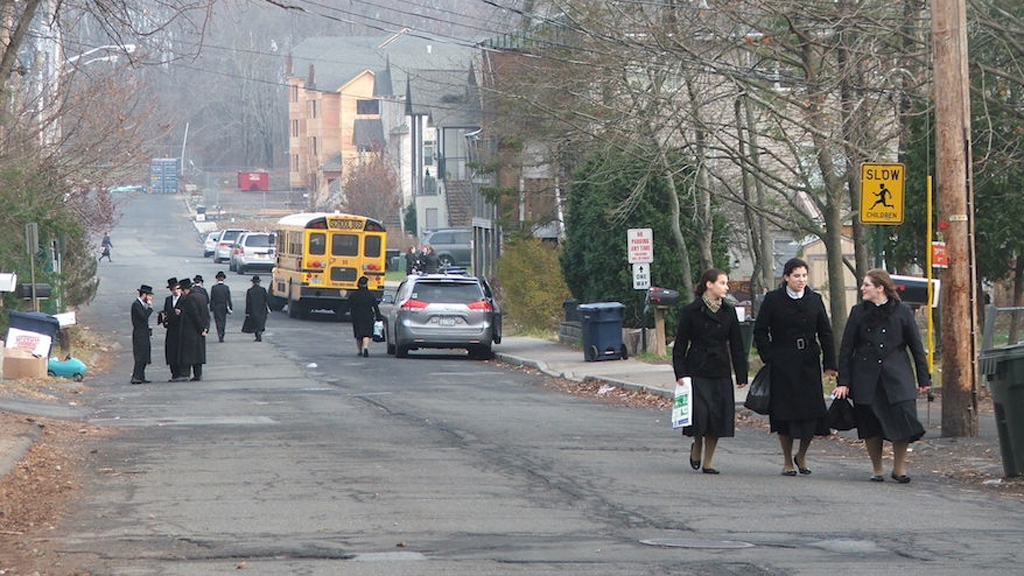Eminent Orthodox leaders among postwar Jewish refugees
American Orthodox Judaism in general and yeshiva education in particular were transformed following World War II, when several distinguished rabbis, rosh yeshivas [heads of Jewish academies], and Hasidic rebbes fled Europe and relocated their institutions in America. [A Hasidic rebbe is a religious leader of a particular group of Hasidim, members of a pietist movement which originated in the first half of the 18th century.]
Rabbi Eliyahu Meir Bloch and Rabbi Chaim Mordechai Katz established a Telshe yeshiva in Cleveland in 1941. Initially comprised of a small number of European students who had escaped war- torn Europe, by the 1960s the Telshe yeshiva had developed a boys high school, post-high school yeshiva, a kollel [for higher level study], and a girl’s seminary. In 1944, Rabbi Aharon Kotler established the Beth Midrash Gevoha in Lakewood, New Jersey. After developing some outstanding students of Talmud, the Lakewood yeshiva came to have an enormous influence on American Orthodoxy and its graduates established new yeshiva schools and kollels throughout North America.
These transplanted European yeshivas were different from the American institutions established prior to World War II. The American yeshivas established prior to World War II encouraged secular study and promoted programs in rabbinical ordination, while the Telshe yeshiva in Cleveland, Beth Midrash Gevoha in Lakewood, and other postwar yeshivas founded by eminent European rosh yeshivas, encouraged Torah study exclusively, and eschewed accommodation with American mores.
A new era of leadership for modern Orthodoxy
Not all distinguished rosh yeshivas agreed with this approach. A new era of leadership for modern Orthodoxy began when Rabbi Yoseph Dov Soloveitchik, the eminent Talmud scholar, was appointed Talmud instructor at RIETS in 1941. Inspired by Rabbi Soloveitchik’s brilliance in both secular and religious knowledge, modern Orthodox Jews in particular looked to him for direction not only in matters of halacha [Jewish law], but also regarding religious and political issues confronting Jewish life in general. Rabbi Soloveitchik’s leadership was crucial as modern Orthodoxy continued to grow in America alongside a growing community of Haredim [literally “those who fear [God], often referred to as ultra-Orthodox Jews].
With your help, My Jewish Learning can provide endless opportunities for learning, connection and discovery.
Hasidism in America
In addition to new yeshivas headed by prominent Talmud scholars, American Orthodoxy following World War II was also influenced by the arrival of Hasidic refugees. With few exceptions, notably Pinchas David Horowitz, the Bostoner Rebbe, and Rabbi Mordechai Shlomo Friedman, the Boyaner Rebbe, there were no Hasidic leaders in America until the arrival of Rabbi Joseph Isaac Shneerson, the Lubavitcher Rebbe, in 1940, and Rabbi Joel Teitelbaum, the Satmar Rebbe, in 1947.
While individual Hasidim had [immigrated] to America as early as the 1880s, many had abandoned their attachment to Hasidic ways. With no Hasidic leader or community of fellow pietists, immigrant Hasidim tended to assimilate into the mainstream of Orthodoxy.
Since World War II, several Hasidic courts, including Lubavitch, Satmar, Bobov, Skver, and others, have developed sizable communities in Borough Park, Crown Heights, Williamsburg, Monroe, Monsey, New Square, and Toronto. With great resourcefulness, they have built yeshivas, synagogues, charities and other institutions of Orthodox Jewish life.
While Hasidim in America formally eschewed accommodation with the modern world, and their distinct custom, dress, external appearance, and exclusive neighborhoods set them apart form other Orthodox Jews, they have adapted aspects of American society into their community. Modern technology, business and public relations skills, and diverse occupations are some of the ways in which Hasidim have been affected by American life.
The result: self-confident American Orthodox communities
The transplanting of Eastern European yeshivas and the development of Hasidic courts were not the only features of American Orthodoxy’s development since World War II. The explosion of day schools and yeshivas in cities with relatively small populations of Orthodox Jews, the formation of kollels, the emergence of religious returnees, or baalei teshuva, are additional examples of an American Orthodoxy that has transformed itself during the past few decades. Aided by an increasingly tolerant, multi-cultural America, these achievements, together with a relatively high birthrate, has brought about a growing self-confidence among America’s Orthodox community.
Reprinted from the American Jewish Historical Society’s American Jewish Desk Reference: The Ultimate One-Volume Reference to the Jewish Experience in America, published by Random House.
Hasidic
Pronounced: khah-SID-ik, Origin: Hebrew, a stream within ultra-Orthodox Judaism that grew out of an 18th-century mystical revival movement.
Midrash
Pronounced: MIDD-rash, Origin: Hebrew, the process of interpretation by which the rabbis filled in “gaps” found in the Torah.
Talmud
Pronounced: TALL-mud, Origin: Hebrew, the set of teachings and commentaries on the Torah that form the basis for Jewish law. Comprised of the Mishnah and the Gemara, it contains the opinions of thousands of rabbis from different periods in Jewish history.
Torah
Pronunced: TORE-uh, Origin: Hebrew, the Five Books of Moses.
yeshiva
Pronounced: yuh-SHEE-vuh or yeh-shee-VAH, Origin: Hebrew, a traditional religious school, where students mainly study Jewish texts.
frum
Pronounced: FROOM (oo as in hook), Origin: Yiddish, devout or pious, generally used to identify someone as Orthodox, or strictly observant of Jewish law.



